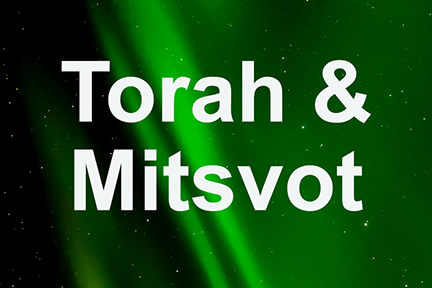Torah and Mitsvot
The Kabbalah is the mystical and esoteric explanation of the Torah. All the profound secrets explained in the Kabbalah, are alluded to in the letters, words and different stories narrated in the Torah. These stories as well as the shape of the letters, the vowels, and the cantillation notes are a Levush – outer garment on the real message and meaning of the Torah. The different systems of Sephirot and configurations of lights and energies are represented by the people and events in the Hebrew texts of the Torah. Therefore, the translations only cover the most basic meaning and can not reach into the real purpose and signification of the Torah as explained in the Zohar:
“Rabbi Shimon said: Woe to this man who says that the Torah came to simply relate stories in an ordinary language, because if this is so, even in these times we could make a Torah from ordinary tales, and even nicer than from those [tales]. If the Torah came to explain worldly subjects, even the governors of the [present] world have more interesting stories. If so, let’s follow what it [tale] says and make a Torah of it in the same way. But really, all that the Torah says is of very high nature, and of supernal secrets.
Therefore, the story in the Torah is the garment of the Torah. The one that thinks that this garment is itself the Torah and that there is nothing else, let his soul swell and have no part in the world to come. For this reason, King David said: (Tehilim, 119. 118) “Open my eyes so I may glaze the wondrous things in your Torah”. Meaning what is under this garment of the Torah.
(Zohar, Bamidbar, Behalotekha 58- 64)
The Torah has 248 positive and 365 negative commandments. Similarly, there are 613 veins and bones in man, 613 parts to the soul, and 613 lights in each Sephira or configuration. This number is not arbitrary, as there are important interrelations and interactions between them.
The Torah contains four levels of comprehension, of which the highest is the Sod (secret). At this level, the Torah explains to us the goal of creation, the real purpose of all the commandments and their influence on the Sephirot.
Through the knowledge of Kabbalah, we can arrive at a level of true understanding of the will of the Creator, His guidance, the creation, and in a way, “decode” the profound secrets of our holy Torah.
Mitsvot – commandments
In the Torah there are 613 Mitsvot and each one corresponds to one of the 613 veins and bones of man and to one of the 613 parts of his soul. By observing the commandments, man reinforces their strength, and by not accomplishing them, he, in a way, weakens them.
The Mitsvot were given for three main reasons:
· To reinforce and purify man
· To act on and influence the guidance
· To help accomplish the Tikun of the creation
After the breaking of the vessels and the fall of the 288 sparks, man has to act and participate in the ascent of the fallen sparks to their origin. This can be done by accomplishing the Mitsvot and by the prayers. As there are different levels of grasping the meanings and purpose of our actions, there are also various possibilities and powers of influence, depending on the understanding and intention of our acts.
The husks are the manifestations of the negative force to obstruct the lights of the Sephirot, and this degradation is caused by the sins committed by man. When accomplishing the Mitsvot, the lower beings send positive energies to weaken these husks and detach them from the higher lights, and thus remove any obstacles from the inflows and outflows of positive energies. Therefore, before each prayer and performance of the commandments of the Torah, we try to unify the masculine and feminine configurations so there will be harmony on high, and that a result or inflow of abundance will come down to us.
By understanding the profound meanings of these commandments as explained in the Kabbalah, we realize the enormous love that the Lord bestows to His creatures by allowing them to be part of this dynamic system, and by giving them the means and tools to reach the highest realms.










